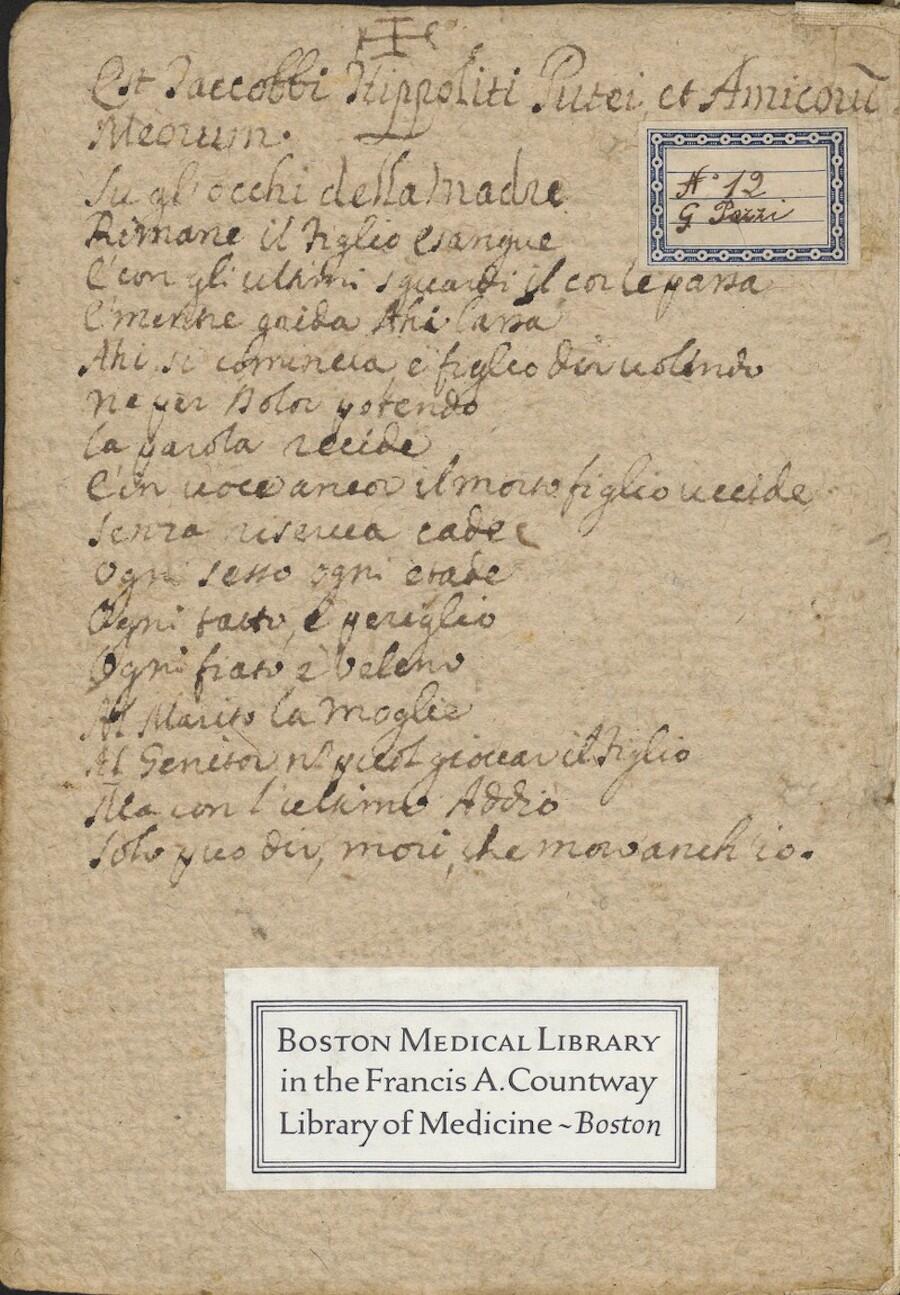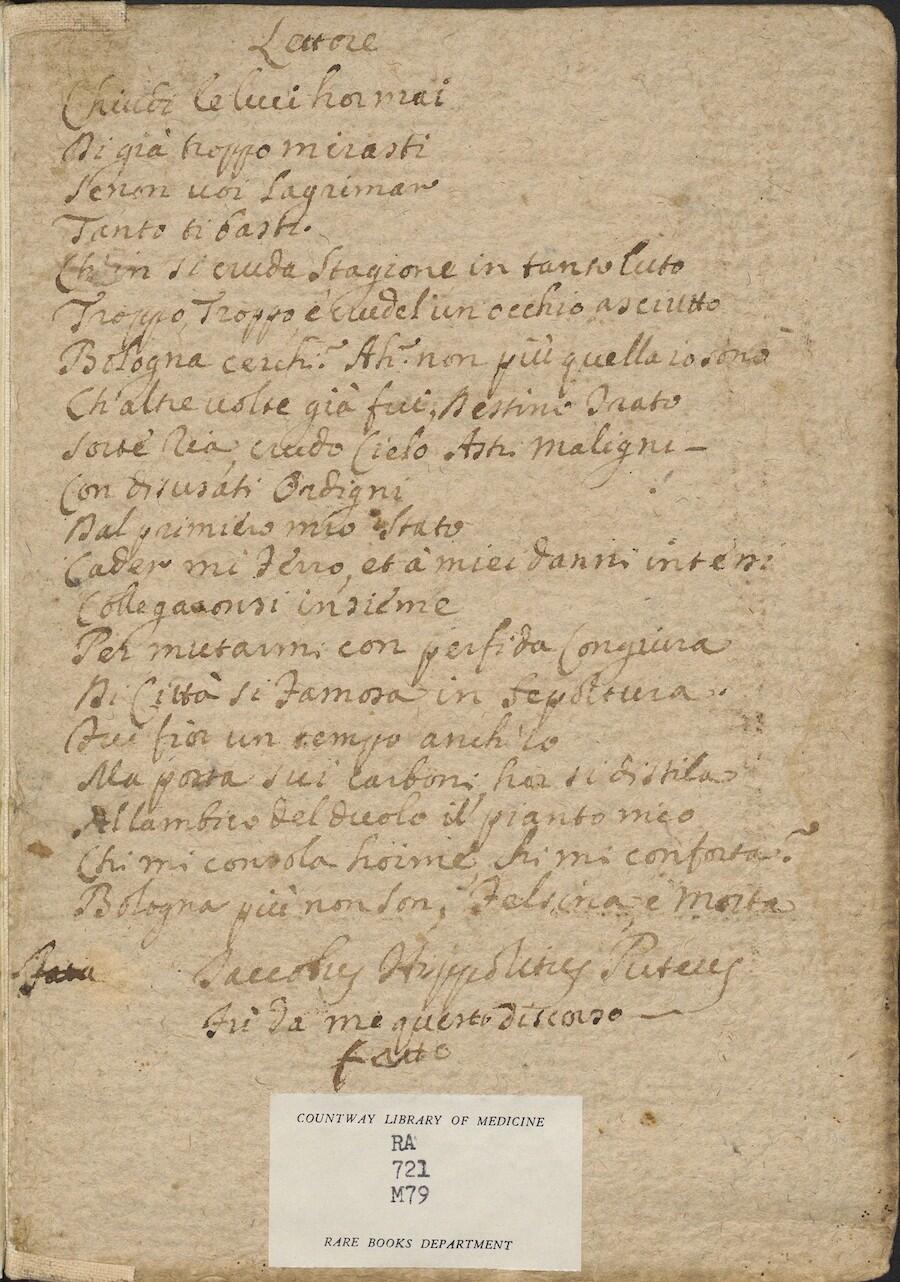Pietro Moratti, Racconto De Gli Ordini E Provisioni Fatte Ne' Lazaretti in Bologna, E Suo Contado in Tempo Del Contagio Dell'anno 1630 (Bologna: Presso Clemente Ferroni, Ad Instanza Di Bartolomeo Cavalieri, & Cesare Ingegnieti, 1631)
Francis A. Countway Library of Medicine, Rare Books RA721 .M79
https://curiosity.lib.harvard.edu/contagion/catalog/36-990056857690203941
Commentary
The Countway Library at Harvard holds a copy of a first-hand account of the public health measures enacted by the city of Bologna’s government during the devastating plague epidemic of 1630. Written and published in 1631 by Pietro Moratti, the abbot of the prominent Church of Santo Stefano, the print account and the manuscript poems inscribed on the inside of its front and back covers offer us the opportunity to reflect on administrative, religious, and emotional responses to plague and on the lingering impact of memories of epidemics in communities that suffered.
Outbreaks of plague in Italy led to flurries of correspondence across the peninsula, reporting on local cases, sharing rumors of origins, and reporting on measures being taken in different cities. If we are to take Moratti at his word in the prefatory letters to readers, this book began as a response to a report he had received from the canon of Urbino, Giacomo Michelori.[1] The final published form of the Racconto de gli ordini e provisioni fatte ne' lazaretti in Bologna, e suo contado in tempo del contagio dell'anno 1630 (Account of the orders and provisions made in the lazarettos in Bologna and its surroundings in the time of the contagion of 1630) is 124 pages of text, arranged mostly chronologically, recounting the progression of the plague outbreak in Bologna and the people and measures involved in combatting it at the city’s lazarettos. Moratti paid particular attention to documenting the doctors who served at the lazarettos and describing the personnel—religious, medical, and custodial—who kept these institutions running, despite high mortality among both patients and caregivers. Interspersed throughout this narrative, Moratti also included the text of forms used to report daily counts of illnesses and deaths, licenses that individuals carried upon leaving the lazaretto, instructions for those returning from quarantine, lists of medicines used in the lazaretti, and even recipes for specific medications and perfumes thought to cure the illness. At the end of the volume, Moratti calculates the total deaths reported in Bologna and the surrounding countryside between June and December 1630 to have been 30,879 people.[2]
Despite widespread scholarly interest in the history of Italian plague epidemics in general, and in the public health edicts during this plague outbreak in Bologna in particular, Moratti’s book is one of many texts about plague that has received hardly any scholarly attention.[3] In addition to instigating exchanges of news, plague outbreaks were often followed by a flood of printed materials that served as immediate recommendations for contemporaries and as sites of memory for future generations.[4] Manuscript evidence in the Countway Library’s copy of Moratti’s account reveal its continued relevance as a source of local memory and a site of emotional and poetic reflection a century after Bologna’s 1630 plague epidemic.
The Countway Library’s particular copy of the Racconto has two poems inscribed in manuscript on the insides of the covers binding Moratti’s text. Above the first poem and under a sign of the cross, Giacomo Ippolito Pozzi claims responsibility for the poem along with his friends. The poem at the end of the book, which is written in the same hand, is followed by the statement “I, Giacomo Ippolito Pozzi, made this speech.” Pozzi would go on to become an important figure in the Enlightenment religious circles of the Bolognese Pope Benedict XIV, first in Bologna and then in Rome. However, Pozzi likely inscribed these poems in Moratti’s text much earlier in his life. He was born in Bologna in 1718 and took religious orders in 1734, at which point he changed his name to Cesareo Giuseppe. We can therefore date Pozzi’s poetic inscription to before 1734, and probably to his period of study at the Olivetan monastery of San Michele in Bosco between 1730 and 1734.[5] Moratti’s book was dedicated to an Olivetan abbot, so it is likely that the monastery owned a copy, though it is also possible that the book was part of Pozzi’s personal library, since the young scholar’s father was well known as both a physician and poet. We should certainly read Pozzi’s poetic engagement in the margins of Moratti’s book as a sociable endeavor, since he inscribed the book as belonging to him “and his friends” under the sign of the cross during his time at the monastery.
Despite Pozzi’s claims to having written the poems he inscribed in Moratti’s Racconto, the poems were not actually his own compositions. In fact, Pozzi excerpted and copied both texts from a longer poem written by the Augustinian friar Lodovico Della Casa.[6] The two poems that Pozzi created out of Della Casa’s 1673 Genova piangente per la peste (Genoa Weeping from the Plague) differ from their source in three meaningful ways. First, the punctuation, line breaks, Italian spelling, and accents differ between the original text and Pozzi’s rendition.[7] Second, the poem inscribed on the inside of the back cover of the Racconto is taken from two different parts of the poem.[8] Based on these two sets of variations, it is possible that when Pozzi inscribed this poetry, he was doing so from memory, recalling the meter and rhyming couplets, but occasionally mistaking the precise words, though without drastically altering the meaning. Finally, Pozzi changed references to Genoa in the poems to Bologna, personalizing these religious laments about the destruction wrought by plague.
The poem itself, written by Della Casa and rewritten by Pozzi, offers a straightforward religious response to the devastation of plague. The first section Pozzi reproduces is a lamentation, reflecting on Mary mourning Christ’s death on the cross. So too, plague was killing young and old, men and women, parents and children. The morbid final lines—“Die now, that I will die with you too”—focus not on solace so much as on acceptance of death. Pozzi addressed the “second” poem directly to his reader (“Lettore”), creating a new audience at the monastery in Bologna for the poem he had plagiarized from Della Casa. Della Casa’s poem meditates on someone searching for Genoa—here silently replaced by Pozzi in the text with Bologna—and the city answers in the first person. The city laments that it no longer exists, killed by the evil alignment of the stars.[9] Despite this desperate reflection, Bologna was still living a century later. Indeed, I suggest that Pozzi gave this speech, drawing on Della Casa’s poem, as part of a 1730 celebration at San Michele in Bosco marking the 100th anniversary of Bologna’s liberation from the plague outbreak of 1630. In so doing, Pozzi adapted Della Casa’s religious poetry about Genoa and inscribed it onto the pages of Moratti’s account of Bologna.
Public health measures, Catholic piety, poetic performance, and the memorialization of epidemics come together in the pages of the Countway Library’s copy of Moratti’s Racconto. This copy shows how a book can become a site of memory and a historical repository for understanding how generations of individuals reflected on outbreaks of plague.[10] It requires starting from the acknowledgement that the 17th-century book now in Boston has not always been there, and then working back through the texts and the contexts in which people engaged with this particular object. Readers leave marks in books that permit us now to reconstruct use and reuse, to interpret and reinterpret, and of course to reflect on memory, loss, and the history of epidemic disease.[11]
Transcription and Translation of Manuscript Poems
Inside Front Cover
[cross]
Est Jaccobbi Hippoliti Putei et Amicoru[m] Meorum
Su gl'occhi della Madre
rimane il figlio esangue
e con gli ultimi sguardi il cor le passa,
e mentre grida: ‘Ahi lassa!
Ahi sì comincia’, e figlio dir volendo,
nè per dolor potendo,
la parola recide,
e in voce ancor il morto figlio uccide.
Senza riserva cade
ogni sesso, ogni etade.
Ogni tatto è periglio.
Ogni fiato è veleno.
Al marito la moglie,
Al genitor non può giovar il figlio,
Ma con l'ultimo Addio
Solo può dir, mori, che moro anch'io.
The image of the bloodless son[12] remains in the eyes of the mother[13] and with his last glances, he pierces her heart, while she shouts “Alas! So it begins!” And wanting also to say “son,” but unable due to the pain, she bites back her words, and once again with her voice kills the already dead son. Without reservation, sexual and age differences disappear. Every touch is danger, every breath is poison. The wife cannot be of help to the husband, nor the child to its parent, but with the final goodbye, one can only say, “Die now, that I will die with you too.”

Inside Back Cover:
Lettore,
chiudi le luci hormai,
di già troppo mirasti.
Se non v[u]oi langrimar
tanto ti basti.
Ch'in sì cruda stagione in tanto lutto
troppo, troppo è crudel un occhio asciutto.
Bologna cerchi? Ah' non più quella io sono,
Ch'altre volte già fui. Destino irato
sorte ria, crudo cielo, astri maligni.
Con disusati ordigni
dal primiero mio stato
cader mi fero, et à miei danni intesi
collegaronsi insieme
per mutarmi con perfida congiura
di Città sì famosa in Sepoltura.
Fui fior un tempo anch’io
Ma posta sui carboni, hor si distila
Al lambico del duolo il pianto mio.
Chi mi consola, hoimè, chi mi conforta?
Bologna più non son, Felsina è morta.
Iaccobus Hippolitus Puteus
Fui da me questo discorso fatto
Reader, close your eyes now; you already saw too much. If you do not want to cry, let so much suffice, because, in this brutal season, in so much mourning, a dry eye is too, too cruel a thing. You are looking for Bologna? Ah, I am no longer that place that I once was. Angry destiny, wicked fate, cruel heavens, spiteful stars—with their uncommon machinations they caused me to fall from my previous state, and focused on damaging me they teamed up to change me, through this disloyal conjunction, from a once famous City into a Graveyard. I too was once a flower, but now, placed upon the burning coals, my crying is distilled on the alembic of pain. Who can console me now, eh? Who can comfort me? I am Bologna no longer, Felsina[14] is dead.
I, Giacomo Ippolito Pozzi, made this speech.

Notes
It is my pleasure to thank Federica Favino, Shannon McHugh, Ambrogio Camozzi Pistoja, and Valeria Castelli for their assistance identifying and translating these poems.
[1] Pietro Moratti, Racconto de gli ordini e provisioni fatte ne' lazaretti in Bologna, e suo contado in tempo del contagio dell'anno 1630 (Bologna: 1631), a3r.
[2] Moratti, Racconto, 120.
[3] The literature on Italian plague outbreaks is extensive. For some highlights available in English (none of which mention Moratti’s text), see Carlo M. Cipolla, Cristofano and the Plague (Berkeley: University of California Press, 1973); Carlo M. Cipolla, Faith, Reason, and the Plague in Seventeenth-Century Tuscany (Ithaca, N.Y.: Cornell University Press, 1979); Carlo M. Cipolla, Fighting the Plague in Seventeenth-Century Italy, Merle Curti Lectures, 1978 (Madison: University of Wisconsin Press, 1981); Giulia Calvi, Histories of a Plague Year: The Social and the Imaginary in Baroque Florence, Studies on the History of Society and Culture 8 (Berkeley: University of California Press, 1989); Samuel K. Cohn, Jr., Cultures of Plague: Medical Thinking at the End of the Renaissance (Oxford: University Press, Oxford University Press, 2009); John Henderson, Florence under Siege: Surviving Plague in an Early Modern City (New Haven: Yale University Press, 2019). On the Bolognese edicts, see Bernardino Spada, I bandi di Bernardino Spada durante la peste del 1630 in Bologna (Faenza [Ravenna]: Casanova, 2008).
[4] On printed plague treatises following outbreaks, see Colin Jones, “Plague and Its Metaphors in Early Modern France,” Representations, no. 53 (1996): 103, and Cohn, Cultures of Plague, 25–32. On memory and plague in early modern Italy, see Ann G. Carmichael, “The Last Past Plague: The Uses of Memory in Renaissance Epidemics,” Journal of the History of Medicine and Allied Sciences 53, no. 2 (1998): 132–60.
[5] Federica Favino, “Pozzi, Giacomo Ippolito,” in Dizionario Biografico degli italiani, v. 85 (2016), accessed online at https://www.treccani.it/enciclopedia/giacomo-ippolito-pozzi_%28Dizionario-Biografico%29/.
[6] I am very grateful to Federica Favino for helping me to identify this poem. Lodovico Della Casa, Genoua piangente per la peste. Monodia del Padre Lodovico dalla Casa, Genovese, Agostiniano (nella stampa di Nicolò, e fratelli Viola, 1674). It was published in a modern edition as Lodovico della Casa, Genova Piangente per la peste del 1657, Monodia, ed. P. Raffaele Bracco (Genoa: 1972).
[7] I have transcribed the poem adhering to current Italian orthography and punctuation to facilitate comprehension.
[8] The first 15 lines of Pozzi’s copy are found on p. 2–3 of Della Casa’s text (cited above), and the final four lines from p. 23. The poem on the inside front cover was extracted from pp. 29–30 of Della Casa’s text.
[9] Astrology was thought to contribute to outbreaks of plague.
[10] For similar approaches to books of hours, see Virginia Reinburg, French Books of Hours: Making an Archive of Prayer, c. 1400–1600 (Cambridge; New York: Cambridge University Press, 2012), and for censored books, see Hannah Marcus, “Expurgated Books as an Archive of Practice,” Archive Journal, August (2017), http://www.archivejournal.net/?p=7028.
[11] For “Marks in Books,” an influential exhibit from the collections of the Harvard Libraries, see Roger E. Stoddard, Marks in Books, Illustrated and Explained (Cambridge: Houghton Library, Harvard University, 1985).
[12] Christ
[13] Mary
[14] Ancient Etruscan city where Bologna is located.
